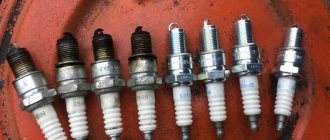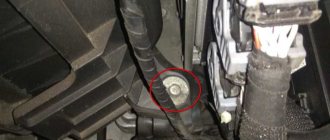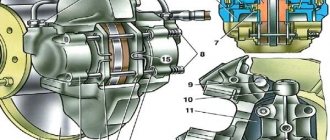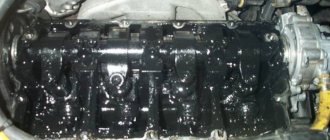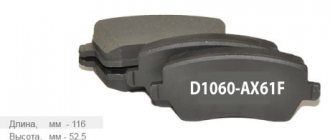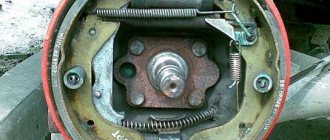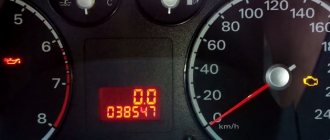Every diligent owner of his car regularly inspects it before leaving, checking the level of oil, brake and coolant. But many car owners don’t even think about periodically checking such “little things” as brake pads (bars), but in vain. There can be no trifles in the issue of accident-free driving, because safety and, in some cases, people’s lives directly depend on their condition.
It is clear that there is no point in dismantling the wheel every time to check the condition of the bars; there are certain signs that tell the driver about the approaching time for their replacement. In this article we will look at how to determine brake pad wear. And also what type of slats are there, which of them have to be changed more often: front or rear. How many thousands of kilometers can they run and what, in general, should be paid attention to.
Types of friction coating of pads
The main working material responsible for the process of stopping a car is a friction layer attached to the metal part of the block. The ideal combination of materials used in their production has not yet been achieved. There are currently four types of brake bars produced:
- Pads with a semi-metallic friction layer applied to them, in which up to 65% of the components are copper, steel wire or iron powder, mixed with graphite for better friction. Their advantage is high heat transfer, and their disadvantages are rapid wear and noise.
- Planks with material glued to them from organic components: high-temperature resin, rubber, glass, Kevlar and carbon. Their positive qualities include less noisy operation and softness, while their negative qualities include a shorter service life and a sufficient amount of dust emitted by them.
- Pads with a small content of metal elements, no more than 30%, with the addition of organic substances (described above). This contributes to good heat transfer, but affects their noise.
- Ceramic planks are currently considered the best option. Their friction layer is made of ceramic fibers with the addition of a filler that includes a small amount of copper. Being lightweight, these pads are more durable in operation and produce less noise.
Urgency
Now it’s time to answer the main question: how long do brake pads last on a car and when should they be changed? What affects their wear and the maximum mileage that is possible for a car without maintenance?
One of the fundamental factors that affects how long a car runs on the same brake pads is driving style. It's no secret that exactly how the braking is done and how often the driver has to press the pedal directly affects the service life of the brake pads and how long they last from replacement to replacement.
Obviously, the less often you have to brake, the longer the service life of the brake pads and the longer they last. However, we should not forget that the force that the pads exert on the disc has a very significant effect on the service life of a particular consumable. In this regard, to save money, it is recommended to brake as smoothly as possible and only at those moments when it is really necessary. It is worth noting that the difference in how long the pads travel with a calm and aggressive driving style is significant, and in some cases it reaches an impressive 35–40%.
Also, the quality of the consumable itself has a strong influence on how long the pads last on the car and the service mileage. It has long been known that, in order to save money, in the production of the most inexpensive pads, materials are used that not only wear out quickly, even if the driving style has always remained quite smooth, but also have weak adhesion properties. There is no need to remind once again that such a short service life of brake pads directly affects the safety of the driver and passengers, and it is especially important to understand this for owners of cars with high mileage, the wear of which is significant.
Factors affecting pad wear
Let's look at the factors that influence how often your brake pads will need to be replaced. There are few of them, but they directly affect indicators such as how long it will take for this to happen, and how many kilometers the car will travel before the corresponding indicator on the instrument panel works. Here are some of them:
- Travel mode. When the car moves in the city, it is often necessary to stop at short intervals, which contributes to rapid wear of the bars.
- Driving style. A non-aggressive driving style puts less stress on the brake mechanism and increases the interval after which the pads will need to be changed.
- The nature of the machine loading. When the trunk is constantly loaded, the load on the front brake trims is reduced, and accordingly, they will need to be changed less often.
Principle of operation
In order to talk sensibly about how long the pads last and after what mileage they need to be changed, it is worth asking the question: how the brake system works and what factors influence the service life of the brake pads.
In fact, the braking system of a car that is not equipped with a large number of safety and stabilization systems is designed quite primitively. By the way, even the number of components and functional units is also reduced to a minimum here.
The brake pedal has a spring mechanism that is connected to a vacuum or electric brake booster through a pipe system. This device works due to the ability of air to become rarefied and change its pressure, and its task is to multiply the force applied to the pedal. This not only takes the load off the driver, but also makes life easier for all the mechanisms whose operation lasts for more than one year.
Through the vacuum brake booster, pressure is supplied to the main brake cylinder, which is usually enough for normal operation of the brake system on any passenger car. It is a small metal cylinder with brake fluid pipes going out and going into it. Its task is to change the braking force between the wheels so that the braking is as uniform as possible. This allows you to achieve good controllability when braking and avoid various types of skidding.
It should be noted that brake pads, which usually last for 30–50 thousand kilometers, are fixed in calipers, which are some kind of fastenings. Being in such fastenings, the block does not play, and therefore the service interval is currently a fairly impressive number. How long does the caliper last? The answer to this question is quite complicated: it all depends on the make and model of the car. It is still possible to say how long a caliper lasts on a typical foreign car: usually its service life is at least 100 thousand kilometers.
Replacement dates and signs
Based on the model of the brake mechanism and the friction material of the bars, manufacturers indicate how many thousands of kilometers the pads can last. Manufacturers also recommend when it is necessary to change the strips, focusing on the remaining minimum permissible friction layer.
All this is described in the instructions for the car, but there are average standards, the value of which ranges from 20 to 30 thousand km, for the front slats in disc brakes. And for drum and disc type rear brake pads, this mileage interval in km must be multiplied by two.
The weight of the machine also plays a big role in the wear rate. The above figures are relevant for small passenger cars weighing up to 1300 kg. If we consider large sedans weighing about 1600 kg, then the wear of the bars will occur one and a half times faster. For cars with a curb weight of 1800 kg or more, the pads will need to be replaced after they have covered a distance half as much as a small passenger car can travel.
If the car was bought used, there is often no way to find out when the pads were last changed and what their mileage was. Some signs will help you understand that it’s time to replace them:
- The pad wear warning light on the instrument panel came on. Some brake pads have an electronic or mechanical indicator that signals when the friction material has worn down to the minimum limit and it is time to replace them.
- There was a sound when the car stopped. This sound occurs at a certain percentage of wear of the friction material, when it is worn down to metal.
- When stopping suddenly, a sound is heard and a beating is felt in the area of the wheels. The reason for this is uneven wear of the pads or cracks and chips that may occur on the disc or friction layer. In this case, even the indicator, if present, may not work. Uneven wear of the friction layer is dangerous because after a certain number of kilometers you will have to change not only the strips, but also the wheel disk or drum.
Recommendations for selection
Rule one and very important: you cannot change the front or rear brake pads one by one. It is necessary to install a set of new elements on the front or rear axle, otherwise when braking the car may seriously drift to the side. Even when one pad is worn out, all four must be replaced . As a temporary option, it is possible to install 2 new parts on one rear wheel.
When choosing new pads in the store, use the following recommendations:
- Products must match the car model and be sold in high-quality packaging with included instructions. The inscriptions on the box are clear and without errors indicating Chinese origin.
- Make sure that the friction material is the same color, without foreign inclusions.
- The surface pressed against the plane of the disk must be flat. Small chips along the edges and depressions are allowed if they occupy no more than 1% of the total area of the working plane.
- Cracks at the interface between metal and friction material are unacceptable.
Ideally, you should buy original products in original packaging. This will save you from unpleasant surprises, unscheduled replacements and emergency situations when operating your car.
What material are the pads made of?
All types of brake pads are the same in design: they are a metal plate with a friction coating applied to the surface. The composition can vary greatly, so the main varieties are distinguished:
- The friction layer consists of a metal, most often copper, mesh and graphite filling. Such semi-metallic pads have good heat dissipation, but are noisy and wear out quickly.
- The metal content in the coating is less than 30%, the rest is made up of organic fillers (glass, graphite, Kevlar). More efficient and less noisy.
- Made entirely of composite materials, they have good braking properties and are silent, but their service life will be even shorter.
- Fully ceramic pads are made of mineral fibers sintered together with filler and a small amount of copper. The lightest, most effective and durable, but also the most expensive.
Differences in replacement times for front and rear pads
Most modern cars have disc brakes at the front and drum brakes at the rear. Rear drum brakes have a longer service life than disc brakes. This is due to their design features - less dirt and dust gets into closed drums, the contact area of the pads with the braking surface is higher than that of discs, and also because they experience less load during the braking process.
This leads to the conclusion that the rear and front pads are changed at different times, independently of each other.
Main reasons for accelerated wear
Why do some owners' pads become unusable after only 10 thousand km, while another with the same model of car easily drives three times that distance? Wear is a very subtle parameter, depending on many factors:
- Vehicle driving mode – city or highway. In city traffic with frequent stops, the load on the brakes is higher than when driving freely on the highway. At what mileage the pads will wear to a minimum will depend on the routes taken.
- How often the replacement will be done depends on your driving style. A quiet ride helps to increase service life, while aggressive driving leads to frequent overheating and early wear of both discs and pads.
- Malfunction of the rear brake circuit. In this case, the front brakes have an increased load. If the rear of the car is additionally loaded, the force is distributed more evenly, and accordingly, the mileage of the front and rear pads increases.
- In the off-season, all parts of the brake system will be exposed to unfavorable climatic factors (moisture, dirt, ice), and in winter they will also be exposed to aggressive chemicals, which also does not extend service life. Those. The more often you drive in bad weather, the lower the resource.
- The presence in the car of complex electronic assistants that simulate the effect of differential locking by braking the wheel reduces the life of the pads.
What determines the wear of brake discs?
The degree of wear of brake discs depends on many factors. Among them:
- Driving style of a car enthusiast . Naturally, with frequent sharp braking, excessive disc wear and brake pad wear occur.
- Operating conditions of the machine . In mountainous or hilly areas, brake discs wear out faster. This is due to natural reasons, since the braking system of such cars is used more often.
- Transmission type . In cars with a manual transmission, discs and pads do not wear out as quickly. Conversely, in cars equipped with an automatic transmission or CVT, disc wear occurs faster. This is explained by the fact that to stop a car with an automatic transmission, the driver is forced to use exclusively the brake system. But a car with a manual transmission can often be slowed down using the engine.
- Type of brake discs . Currently, the following types of brake discs are used on passenger cars: ventilated, perforated, notched, and solid. Each of the listed types has its own advantages and disadvantages. However, as practice shows, solid discs fail most quickly, while ventilated and perforated ones last longer.
- Wear resistance class . It directly depends on the price and the type of disk indicated above. Many manufacturers, instead of wear resistance class, simply indicate the minimum mileage for the car for which the brake disc is designed.
- Brake pad hardness . The softer the brake pad, the more gentle it works with the disc. That is, the disk resource increases. In this case, the braking of the car will be smoother. Conversely, if the pad is hard, it will wear out the disc faster. The braking will be sharper. Ideally, it is desirable that the disk stiffness class and the pad stiffness class match. This will extend the life of not only the brake disc, but also the brake pads.
- Vehicle weight . Typically, larger cars (for example, crossovers, SUVs) are equipped with wheels with a larger diameter, and their braking system is more reinforced. However, this case indicates that a loaded vehicle (that is, carrying additional cargo or towing a heavy trailer) will wear out the brake discs faster. This is explained by the fact that to stop a loaded vehicle, more force is required in the braking system.
- The quality of the disc material . Often, cheap brake discs are made of low-quality metal, which wears out faster and may also develop defects (curvatures, sagging, cracks) over time. And accordingly, the higher quality the metal from which a particular disk is made, the longer it will last before replacement.
- Serviceability of the brake system . Malfunctions such as problems with the working cylinders, caliper guides (including lack of lubrication in them), the quality of the brake fluid can affect the rapid wear of the brake discs.
- Availability of anti-lock braking system . The ABS system works on the principle of optimizing force, in which the pad presses on the brake disc. Therefore, this extends the life of both pads and discs.
Please note that usually the wear of the front brake discs always exceeds the wear of the rear ones since they are subjected to significantly greater force. Therefore, the service life of the front and rear brake discs is different, but at the same time there are different requirements for wear tolerance!
On average, for a standard passenger car used in urban conditions, a disk check must be performed approximately every 50...60 thousand kilometers. The next inspection and wear measurement is done depending on the percentage of wear. Many modern wheels for passenger cars easily operate for 100...120 thousand kilometers under average operating conditions.
This is interesting: How to change the alternator belt on a Lada Granta
How to understand that it is time to change brake pads without direct access to them
Having figured out at what mileage the pads should be replaced with new ones, let’s look at the main symptoms of wear using methods that do not require special tools and are accessible to everyone.
- If you have alloy wheels and disc brakes, you can sometimes observe the pads directly:
- The simplest option. The pad wear indicator will work. There are electronic and mechanical. Electronic is a light on the dashboard. It is triggered by a short circuit on the sensor when it touches the metal.
The principle of a mechanical indicator is even simpler: when braking, a characteristic whistle of the indicator will be heard.
If there is no indicator, you will hear the sounds of metal rubbing against metal as the friction layer is destroyed or abraded.
- Pay attention to the amount of brake fluid. As a rule, it is filled to the top. In the absence of leaks, the drop in level is caused by increased piston stroke due to pad wear. A critical level drop is also indicated by a warning lamp.
- When braking heavily, you can feel a vibration in the steering wheel. Usually occurs due to deformation of the pad or brake disc itself. You can carry out a test: after accelerating to 80 kilometers, perform emergency braking (make sure that no one is behind you!) - if there is a beating on the pedals, a pull to the side, then you need to replace the pads and, very likely, the discs as well.
- The braking distance to a complete stop increased, the brake pedal began to grab at the end of the stroke, and other oddities appeared in the operation of the brake pedal.
- There is a pull to the side, and skidding occurs on slippery surfaces due to uneven braking.
Instructions for calculating fuel consumption. Read it, it will help you save money.
Proper battery charging will save you in winter. Find out how to do it correctly and quickly.
Stages and features of diagnosis
The measuring stage of the test involves the use of a caliper, which will help make thickness measurements. At approximately 5-8 points, moving around the disk, measure the thickness. If it varies along the radius of the part, there are signs of curvature and uneven wear.
Check the information from the manufacturer to understand whether the wear limit has already reached or not. I cannot say which indicators are correct and which are not, since different discs have their own wear limits.
Then a visual inspection is carried out. The disc should be examined for cuts, chips, dents, scratches and other defects on its surfaces. If they are, the spare part will have to be replaced.
Do not forget about the rule of pairwise replacement on the same axis. That is, when the left front disc is changed, the front right one also changes at the same time.
If you want to assess the condition of the elements without removing the wheels, this can be done by checking while driving. With severe wear, characteristic signs appear:
- the car brakes jerkily;
- a grinding sound appears;
- there is a squeaking sound when you press the brake;
- other extraneous sounds are heard;
- the driver feels a beat on the steering wheel;
- the beating is also felt in the gas pedal;
- When the brake pedal is pressed, the braking system is locked.
I strongly do not recommend waiting for such symptoms to appear. It’s better to periodically do simple diagnostics in your garage through visual inspection and measurement. This is usually done every 10-15 thousand kilometers, if wear symptoms do not appear earlier.
..
Inspection of pads at a service station or yourself
For inspection, you will need to remove the corresponding wheel. Those. you need a jack or lift (pit). You will also need a caliper and a ruler to measure the remaining friction layer.
Typically, the minimum permissible thickness of the residual layer is 1.5 - 2 mm.
A brake disc with deep grooves also indicates severe wear. For discs, the minimum permissible thickness is 10-12 mm.
The wear of the brake pads in the rear brake drums is determined through a special inspection hole in the drum body; if there is none, then you will have to remove the entire brake drum and use a ruler or caliper to measure the remaining thickness of the friction layer. Indirectly, the condition of the rear pads is related to the handbrake, when it stops holding or operates on the last click - this indicates increased wear.
How are drum brakes different from disc brakes?
One of the disadvantages of drum mechanisms compared to disk ones is the lack of a self-cleaning effect. Wear products from the brake pads remain inside the drum and leave characteristic marks on the working surfaces of the friction elements.
Due to the abundance of wear products, characteristic grooves formed on the working surface of the pad. The actual wear of the linings was about 30%.
Due to the abundance of wear products, characteristic grooves formed on the working surface of the pad. The actual wear of the linings was about 30%.
Editorial Kalina is often used to participate in various competitions. That is, the conditions of its operation can be called difficult. However, to our surprise, the wear on the original pads turned out to be small - about 30%. Probably the reason is that the car has a relatively small mass, and its dynamic performance is not outstanding.
Deep grooves on the working surface of the drums are the result of exposure to wear products.
Deep grooves on the working surface of the drums are the result of exposure to wear products.
Alas, wear products have significantly damaged the working surfaces of the linings and drums. This can't be fixed. The next time you replace the pads, you will also have to update the drums, otherwise they will immediately damage the new pads. However, there is nothing criminal in the further operation of the car in this form. The reduction in rear brake performance is not noticeable even when driving on a race track. In general, drums, like discs, can survive two sets of friction linings.
How to independently assess the wear of brake pads and discs?
Photo: from the author’s archive
What else you should know about replacing pads
When choosing new pads in a store, you should pay attention to their quality and originality of the manufacturer. It is better to pay attention to trusted companies: ATE, Dafmi, brembo, STS, VATI. Cheap, low-quality products can brake much worse, and in a critical situation they can collapse, which will lead to loss of control over the car.
How can you tell if a particular wheel is slowing down?
Evidence that the brakes on a given wheel are working is a shine on the disc or drum:
Where are brake pads changed?
At an official dealer, or at any service station where they repair chassis. There are also specialists who specialize only in brake system repairs.
Is there an alternative to replacing the pads? How to increase the period of their replacement?
Yes, this is a brake pad restoration. When they simply change the friction layer. The cost is usually equal to or even more expensive than buying new pads, but the friction layer in this case is much thicker and of better quality, according to experts. As a result, the service life of the restored part increases several times.
How long does it take to change brake pads?
According to service station standards, 0.8 - 1.2 hours are allotted for replacing both rear and front pads, depending on the car model.
How often should you change brake discs?
Brake discs and drums do not require regular replacement very often. Usually they are enough for 3-4 sets of pads, after which severe wear of the disc will affect the braking efficiency and service life of the new pads. Sometimes, instead of replacing, it is enough to sharpen the brake disc itself, if its thickness allows it. We do the same with brake drums.
Should I change the pads when replacing brake discs?
Yes, manufacturers recommend simultaneous replacement. This way, new discs will last longer, because... the old pads have already gotten used to the unevenness of the old disc and would begin to wear the new one unevenly.
Over time, each driver develops his own driving style and develops an understanding of how many kilometers the brake pads need to be replaced. By choosing high-quality parts, you ensure safety on the road and extend the service life of the brake system components.
When to change brake pads?
Welcome friends to the DIY car repair website. Many car owners are interested in when to change brake pads, how to diagnose a fault, and which devices to give preference (in case of replacement).
Additional questions and answers
What is the service life of brake pads and brake discs?
There are many factors that influence the average lifespan of your brake components. These include pad type, rotor type, your personal driving style and maintenance. According to most brake pad companies, as well as qualified mechanics, brake pads can last between 30,000 and 120,000 kilometers . At the same time, the front ones wear out about 3 times faster than the rear ones. On average, it is recommended to change pads on domestic cars approximately every 10,000 km, and on foreign cars - every 20,000 km. Actual service life can vary greatly, the main thing is to prosodicly check them and their thickness.
Left - new pads, right - old
The service life of brake discs is quite long - 3-4 times longer than that of pads. But again, it all depends on many other factors, such as how you maintain your braking system and how you drive your car. On average, this is more than 100,000 km. Here you also need to rely on the thickness of the rotors when taking measurements.
How much do new brake discs cost?
The average cost of new brake discs varies from 3,000 to 5,000 rubles each. Some rotors with the best characteristics can cost from 7000+ rubles each. Additionally, prices vary greatly depending on the type, brand, and quality.
New brake discs
When it comes to replacing brake rotors, some people often wonder whether they should buy new or remanufactured parts. Each of these types has its own advantages and disadvantages. For example, aftermarket parts tend to be cheaper and available in a wide range of options, while new brake rotors are easier to select and offer greater quality assurance.
When to change brake pads?
Let us immediately note that in principle there is no exact replacement period. The reason is that there are too many factors on which the integrity and lifespan of the device depends.
This includes driving style, operating conditions, and the quality of the pads themselves. On average, on the front wheels they last about ten to fifteen thousand kilometers.
The rear drum pads last a little longer, and can wear out up to sixty or more.
But even here, wear can be influenced by many factors - distribution of braking forces, quality of braking devices, driving style, and so on. However, in practice, brake pads wear out much faster.
During operation, the thickness of the front or rear pads should not be allowed to be less than 1.5 millimeters.
Otherwise, the quality of braking decreases, the likelihood of damage to the piston of the working cylinder increases, and unnecessary sounds (creaking, squeaking, and so on) begin to irritate. By the way, read here why brake pads squeak.
What to look for when purchasing
Despite the recommendations, brake pads should be replaced at a frequency determined by each driver based on the recommendations provided and his own feelings, or the diagnosis of specialists.
Driving style, quality condition of the brake disc, operating conditions of the pads, weather and climatic conditions significantly affect the condition of the brake pads, which may require replacement much earlier than stated by the manufacturer.
In addition, it is necessary to periodically diagnose the brake system to identify cracks and chips on the disc and pads. All this will ensure the high-quality performance of the automobile braking system and the safety of the driver and others.
How to determine the malfunction?
Checking the degree of wear and making a decision through the brake pads is very simple. It is enough to remove the front wheels one by one and inspect the condition of the disc pads.
If the thickness is less than one and a half millimeters, then the best option is to run to the store, buy a couple of new products and replace them.
Checking the rear brakes will be more difficult - it is necessary not only to remove the wheel, but also to dismantle the brake drum. Next, it remains to measure the thickness using the following algorithm:
Brake Pads, Front, Rear, Replacement Timing.
When to change
front and rear
brake pads
, uneven pad wear, when
to change
pads.
When to change brake pads
When to change
— expert advice on how to replace pads. New project.
In addition to thickness, there are several other reasons to replace the pads:
- Oily surface;
- poor quality of connection to the base;
- strong squeaking noise when braking;
- Pedal vibration when pressing the brake pedal.
Symptoms of wear parts
The general technical condition of the car, including its braking system, can be checked using a personal ODBII scanner. This type of device is widespread on the market and will help save budget and time on visiting a service station. If you do not want to spend large sums on purchasing a device, we can recommend you a budget scanner made in Korea, Scan Tool pro Black Edition.
For about 2000 rubles you will receive a personal diagnostic device comparable to the functionality of most adapters used by diagnosticians at service stations. The main advantages of Scan Tool Pro include diagnostics of all components and assemblies of the car, and not just the engine, as in most Chinese analogues (the scanner diagnoses abs, transmission, airbags, air conditioning system, gearbox, etc.). You can also see in real time the operation of all available sensors, the car’s VIN, its actual mileage, which is very important when buying a used car, and much more.
While driving, there are several signs that you can use to determine when it’s time to change the pads of the front or rear brakes, or even all together. The symptoms are:
- a metallic grinding sound when you press the pedal indicates complete wear of the linings;
- increased travel of the brake pedal, its vibration when pressed;
- when braking, there is a feeling that the front or rear of the car is being pulled to the side, and on a slippery road the car easily goes into a skid;
- the handbrake does not work properly;
- To stop you need to put more force on the pedal.
If, when braking, a metallic grinding and squeaking sound is heard from the wheels, then the question of how long to change the unusable parts is no longer worth asking. Replacement must be done urgently, since there are no friction linings left and the steel base is rubbing against the working surface of the disk.
Never allow the brakes to wear out completely, otherwise you will have to replace the discs along with the pads, which is significantly more expensive.
If you notice one or more symptoms indicating problems with the wheel brake mechanisms, check the condition of the linings. Recommendations for performing diagnostics are as follows:
- If your car is equipped with alloy wheels with large holes, then you won’t have to disassemble anything to inspect the front calipers. If necessary, jack up the car to align the disc opening against the brake mechanism.
- Wheels with steel rims must be removed. Inspect the front brake pads and evaluate the thickness of the linings. If it is less than 3 mm, the parts should be replaced immediately. With a thickness of 3-5 mm you can drive another 1-2 thousand km, no more.
- Rear brakes are disc or drum. The first ones are examined similarly to the front ones, but the second ones will have to be disassembled. Remove the wheel and release the handbrake, then unscrew the drum and carefully knock it off the hub. Unlike the front pads, the rear pads need to be changed when the thickness is 1.5-2 mm.
When, as a result of diagnostics, wear of elements close to the maximum is detected, but replacement is postponed for various reasons, drive carefully and without haste. It happens that a worn lining comes off completely when you press the pedal sharply .
When conducting diagnostics, pay attention to the working surface of the brake drums and discs. If its wear is 2 mm or more (determined by the depth of the groove with a caliper), then the part must be replaced.
How to make the right choice?
So, the decision about the need for replacement has been made. But how to choose brake pads? One of the main parameters when choosing such a product is the operating temperature of the device.
On average, this indicator should be in the range from 300 to 350 degrees Celsius. For VAZ cars, this indicator is sufficient. Adherents of sports driving or drivers who live in mountainous areas are better off giving preference to more “hardy” pads with an operating temperature of about 800 degrees Celsius.
Summing up
It is worth noting that recently the quality of brake pads, along with other consumables, has increased significantly. Therefore, from replacement to replacement you can now drive a significant number of kilometers, which on average ranges from 30 to 60 thousand, depending on the car model and driving style, and you do not often need to change the pads. In any case, it is necessary to approach the choice responsibly in order to avoid unexpected and unpleasant situations on the road.
The efficiency of the braking system largely depends on the technical condition of the pads - the elements pressed against the disc or wheel drum when you press the pedal. They are equipped with linings that gradually wear out and at some point become unusable. The actual lifespan of parts may vary and depend on many factors. Therefore, every motorist must monitor the brake mechanisms of the wheels and clearly determine when to change the pads. To check the wear of the linings, you don’t have to go to a service station; you can check it yourself.

